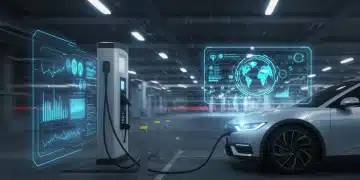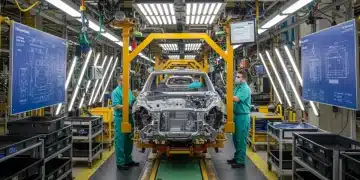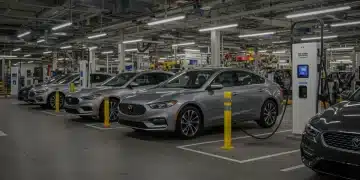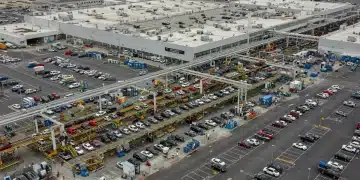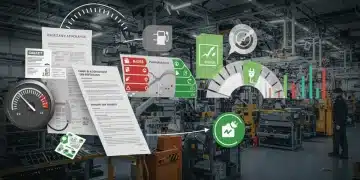Tracking $7.5 Billion US Charging Infrastructure Investment: 2025 Analysis
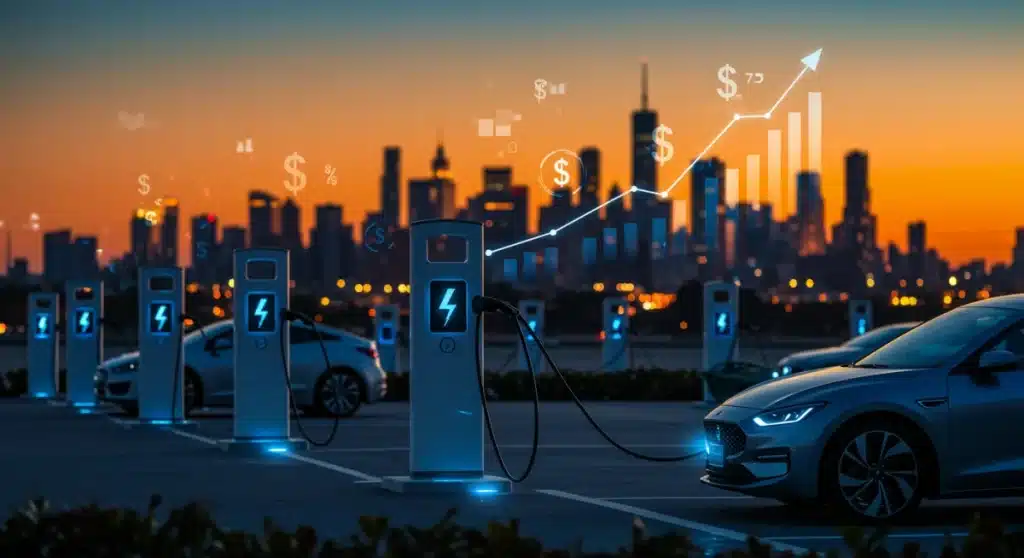
The $7.5 billion investment in US charging infrastructure is poised to significantly accelerate electric vehicle adoption and drive substantial economic growth by 2025, according to recent analyses, enhancing grid resilience and creating numerous jobs across the nation.
As the nation accelerates its transition to electric vehicles (EVs), the monumental task of building out a robust charging network is underway. We are closely Tracking the $7.5 Billion Investment in US Charging Infrastructure: A 2025 Economic Analysis, a critical endeavor set to reshape the automotive landscape and the national economy.
Federal Push for EV Charging Dominates Headlines
The Biden-Harris administration’s ambitious plan to deploy 500,000 EV chargers across the United States by 2030 hinges significantly on the $7.5 billion federal investment. This funding, channeled through the Bipartisan Infrastructure Law, is now actively flowing into states, marking a pivotal moment for electric vehicle adoption and infrastructure development. The goal is to establish a cohesive, reliable, and accessible charging network that alleviates range anxiety and supports the growing EV market.
Recent reports indicate that states are rapidly submitting their plans for deployment, with many already receiving approval and beginning the procurement process for charging equipment. This rapid mobilization is crucial for meeting the aggressive targets set for the coming years. Experts suggest that the initial phases of this investment will focus on establishing charging corridors along major highways, ensuring long-distance travel for EV owners becomes more feasible and convenient.
Strategic Allocation of Funds
The federal government has outlined specific criteria for how these funds can be utilized, emphasizing interoperability, reliability, and accessibility. This ensures that the charging stations built will serve a broad range of EV models and users, regardless of their location or vehicle type.
- Highway Corridors: Priority is given to building charging stations along designated alternative fuel corridors, ensuring seamless travel.
- Equity Considerations: A portion of the funds is earmarked for underserved and rural communities, addressing historical disparities in infrastructure access.
- Standardization: All federally funded chargers must adhere to common technical standards to ensure universal compatibility and ease of use.
Economic Projections for 2025: A Significant Boost
By 2025, the economic impact of this $7.5 billion investment is expected to be substantial, creating a ripple effect across various sectors. Analysts project significant job creation, not just in the manufacturing and installation of charging infrastructure but also in related industries such as maintenance, software development, and energy management. The influx of capital is stimulating innovation and encouraging private sector investment, amplifying the overall economic benefit.
The growth of the EV charging ecosystem also promises to drive down operational costs for businesses and individuals, fostering greater economic efficiency. Reduced reliance on fossil fuels translates into savings that can be reinvested, further bolstering local economies. Furthermore, the development of a robust charging network is seen as a cornerstone for attracting more EV manufacturing and related businesses to the US, creating a virtuous cycle of growth and innovation.
Early indicators suggest that states with proactive deployment strategies are already experiencing localized economic upticks. These include increased demand for skilled labor in electrical trades and construction, as well as opportunities for small businesses to participate in the supply chain for charging components. The 2025 outlook is overwhelmingly positive, with expectations of a tangible shift in economic activity towards green technologies.
Impact on EV Adoption Rates and Consumer Confidence
A primary objective of the $7.5 billion investment is to accelerate EV adoption. A comprehensive and reliable charging network is widely recognized as the single most critical factor in overcoming consumer hesitancy. As more charging stations become operational and visible, consumer confidence in electric vehicles is expected to surge. This infrastructure development directly addresses ‘range anxiety,’ a significant barrier for many potential EV buyers.
The visibility of new charging stations in urban centers, rural areas, and along major travel routes will serve as a constant reminder of the growing feasibility of EV ownership. This psychological shift, coupled with technological advancements in battery life and charging speeds, is projected to drive a substantial increase in EV sales leading up to and beyond 2025. Dealerships are already reporting increased inquiries about charging availability as infrastructure projects gain momentum.
Technological Advancements and Grid Integration
The investment is not merely about installing more chargers; it’s also about fostering technological advancements and ensuring seamless grid integration. Modern charging stations are becoming increasingly sophisticated, incorporating smart grid technologies that can manage energy demand efficiently. This includes bidirectional charging capabilities, where EVs can feed energy back into the grid during peak demand, enhancing overall grid stability and resilience.
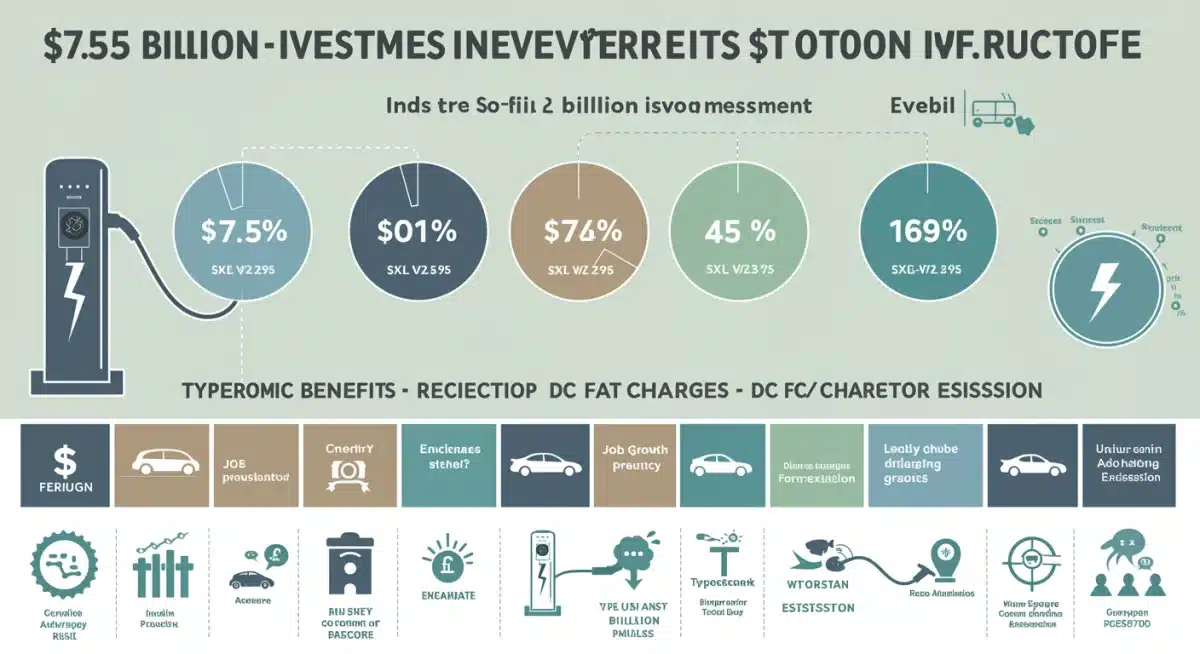
Innovations in fast-charging technology are also a key focus. The goal is to significantly reduce charging times, making the EV refueling experience comparable to traditional gasoline fill-ups. This rapid evolution in technology is crucial for mass adoption and is directly supported by the federal investment, which encourages research and development in these areas.
Key Technological Focus Areas
- Smart Charging Systems: Integrating chargers with the smart grid to optimize energy use and reduce strain on local power infrastructure.
- Ultra-Fast Charging: Developing and deploying chargers that can provide hundreds of miles of range in minutes, not hours.
- Software and Connectivity: Enhancing user interfaces, payment systems, and real-time availability information for a more streamlined charging experience.
State-Level Deployment and Regional Disparities
While the federal investment provides a national framework, the actual deployment of charging infrastructure occurs at the state level, leading to varying rates of progress and regional disparities. States with existing EV mandates and robust state-level incentives are often moving faster, leveraging federal funds to amplify their efforts. Conversely, states with less developed EV policies may face challenges in quickly deploying their allocated funds.
The National Electric Vehicle Infrastructure (NEVI) Formula Program, a cornerstone of the federal funding, requires states to develop comprehensive plans. These plans must detail how they will build out their charging networks, including specific locations, types of chargers, and strategies for engaging local communities. The success of the overall initiative hinges on the effective execution of these individual state plans, highlighting the importance of strong state-federal partnerships.
Some regions are seeing rapid expansion, particularly in states like California, New York, and Texas, which have high EV adoption rates and significant urban populations. However, efforts are also underway to ensure that rural and underserved areas are not left behind, with specific provisions in the federal funding aimed at promoting equitable access to charging infrastructure across all geographic areas.
Challenges and Opportunities Ahead
Despite the significant investment and projected positive outcomes, several challenges remain in the widespread deployment of EV charging infrastructure. These include grid capacity limitations, permitting hurdles, and the need for a skilled workforce to install and maintain the new infrastructure. Addressing these challenges effectively will be critical to realizing the full potential of the $7.5 billion investment by 2025.
However, these challenges also present unique opportunities. The need for grid upgrades stimulates investment in renewable energy sources and energy storage solutions, further advancing clean energy goals. Workforce development initiatives can create new career paths and boost local economies. Moreover, the complexities of siting and permitting can foster innovative partnerships between public and private entities, streamlining processes and accelerating deployment.
The ongoing collaboration between federal agencies, state governments, private companies, and local communities is crucial. This multi-stakeholder approach is essential for overcoming obstacles and maximizing the benefits of this historic investment. The lessons learned in the initial phases of deployment will inform future strategies, ensuring a more efficient and impactful rollout of charging infrastructure nationwide.
| Key Point | Brief Description |
|---|---|
| $7.5 Billion Investment | Federal funding through the Bipartisan Infrastructure Law for nationwide EV charging network deployment. |
| 2025 Economic Impact | Projected job creation, economic growth, and private sector investment across various industries. |
| EV Adoption Acceleration | Reliable infrastructure is key to boosting consumer confidence and increasing electric vehicle sales. |
| Grid Integration & Tech | Focus on smart grid technologies, ultra-fast charging, and robust software for efficient energy management. |
Frequently Asked Questions About US Charging Infrastructure Investment
The main objective is to build a national network of 500,000 electric vehicle (EV) charging stations by 2030, enhancing accessibility and reliability across the United States to accelerate EV adoption and support sustainable transportation.
By 2025, the investment is projected to significantly boost the US economy through job creation in manufacturing, installation, and maintenance, stimulate private sector investment, and foster innovation in green technologies, driving overall economic growth.
States are responsible for developing and executing plans for charger deployment, often leveraging federal funds to meet specific criteria for location, accessibility, and technical standards. Their proactive engagement is crucial for the program’s success.
Yes, the funding includes specific provisions aimed at promoting equitable access to charging infrastructure in underserved and rural communities. This helps address historical disparities and ensures broader access to EV charging nationwide.
The initiative aims to advance smart charging systems for efficient grid integration, promote ultra-fast charging technologies, and enhance user experience through improved software and connectivity. These innovations are vital for mass EV adoption.
Looking Ahead
The ongoing federal investment in US charging infrastructure is more than just a financial allocation; it’s a foundational shift towards a sustainable transportation future. As 2025 approaches, the nation will witness tangible progress in charger deployment and a measurable acceleration in EV adoption. Watch for continued state-level announcements, new technological breakthroughs in charging efficiency, and evolving public-private partnerships that will define the success of this monumental undertaking. This initiative is set to redefine America’s energy landscape, offering both challenges and unprecedented opportunities for growth and innovation.
